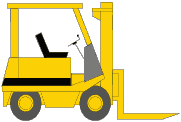

AC POWERED LIFT TRUCKS ?


|
Maintaining top performance |
 |
| This AC-driven lift truck maintains its battery charge, and thus its top performance level, longer than a conventional DC-driven forklift, according to Toyota. Battery regeneration in braking and switching from forward to reverse helps conserve battery power. |
Are forklifts driven by AC motors the next major trend in electrically-powered industrial trucks in the U.S.? DC motors are far and away the standard now in this country. In Europe and less so in parts of Asia, there' s a mix of both motor types.
It' s likely to be some months before we learn whether or not:
Any trend starts with Toyota' s lone venture into selling AC-motor-equipped trucks for commercial applications in North America.
Or, perhaps, this new product introduction just sparks the creation of a new, niche market.
By rolling out its pneumatic-tired, all-electric 7FB models, Toyota is paving a path to the first commercial uses of AC-motor-powered, industrial trucks in U.S. plants and warehouses. Except for the AC motors and some added safety equipment, the Toyota trucks have features much like others already sold in the United States.
Toyota gave Modern Materials Handling an exclusive preview of what U.S. end users can expect from this truck line and its innovative motor technology.
Already launched into markets in Europe and Japan, the new Toyota counterbalanced truck line is fully electric. AC drive motors ranging from 7.6 kW to 11.9 kW power the vehicles to speeds of 10 m.p.h. Load handling AC motors ranging from 9.5 kW to 14.4 kW will lift loads from 1 to 2.5 tons. (Smaller AC motors control power steering.)
Potential customers here should get a chance at hands on experience with the trucks later this summer, says Brett Wood, Toyota' s national product planning manager. U.S. dealers for Toyota Industrial Equipment were scheduled to get their first look at a 7FB truck last month.
What' s the big deal?
European lift truck manufacturers and users might well ask, "What' s the big deal?" Over there AC motors are used to power a number of the truck models made by the leading brands.
We asked several major manufacturers about AC technology and their plans to bring it to the U.S. Here' s what we heard.
Linde, the largest lift truck maker in the world and a major force in Europe in this industry, introduced the technology to Europeans some years ago, for example. Linde's Fiat/OM division sells AC trucks worldwide.
"We have this technology in place should we ever decide to offer it in the U.S.," says Mark Rossler, marketing manager, Linde Lift Truck, Summerville, S.C. "Currently we have no plans to do so."
Jungheinrich, meanwhile, offers in Europe a four-wheel electric counterbalanced truck that' s AC driven. There also are Steinbock Boss very-narrow-aisle stacker vehicles that run on AC power, and are sold to overseas users.
|
BT Industries introduced its AC-powered reach trucks to European customers several years ago. "These trucks have been a great success," says Raymond Corporation president and CEO James Malvaso. BT Industries, which is Raymond' s parent firm and is headquartered in Sweden, is eyeing other opportunities to apply AC technology to narrow-aisle electrics, he adds, for users in Europe.
In the U.S., however, Raymond is still investigating AC motor technology. Further testing needs to be done to prove its worth and reliability, Malvaso says. "I believe that R & D expenses and risks belong in the manufacturer' s factory," he maintains, rather than having the lift truck customer verify the technology' s benefits and costs.
Even so, Malvaso says he is "more positive" on the technology' s future for U.S. users than he was only a year or so ago. Trucks equipped with AC motors can offer benefits: With an AC motor, the lift truck makes smoother transitions from forward to reverse. The technology provides a regenerative capability to conserve battery power. Controls for AC motors now are much less costly than they were only a year or two ago. Finally, the AC motor' s brushless design could–and Malvaso says he stresses the word "could"–lead to lower maintenance costs.
Nissan, meantime, is also keeping close watch on prospects for a shift from DC to AC power. "Nissan has had AC motor technology under study and test for a number of years," says Keith Allmandinger, director of marketing and product support for Nissan Forklift, North America. "It offers distinct advantages in the areas of power and speed. It will offer manufacturers the ability to configure their trucks to gain additional capacities due to the motor' s compact design.
"This technology will certainly hit the North American market in the year 2000 as it clearly has advantages for end users and manufacturers alike," the Nissan exec concludes.
Performance, power from AC
Toyota believes its AC lift truck has been well tested and is ready for U.S. users to discover its benefits. More performance, power, and precise control of that power are among the advantages claimed for the 7FB.
Torque and acceleration are greater than they are in comparable trucks with DC motors, says Adam Hughes, electric product planning manager. Expect the AC truck to have more power going up a grade than a DC vehicle, moreover.
Loaded or unloaded, the AC truck delivers an optimal level of performance, he says. And, up to the point of about 80% discharge of the battery, the AC truck' s level of performance and productivity remain near 100% (chart).
"The truck has a compact, high performance motor much like the reliable motors that tirelessly power air conditioners," says Hughes. Not needing the brushes and contactors of a DC motor, an AC motor also is far easier to maintain, he says. "It's virtually maintenance free."
Operators accustomed to DC trucks and the lag time that occurs when shifting from forward to reverse will find there's no lag time changing direction on the AC truck, Hughes explains.
04/01/2000 Modern Materials Handling